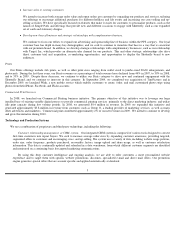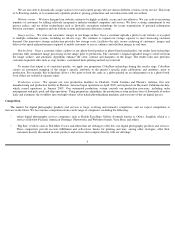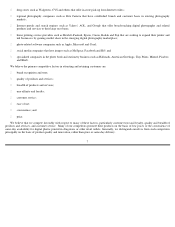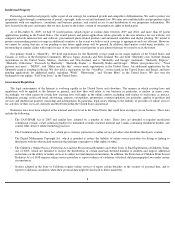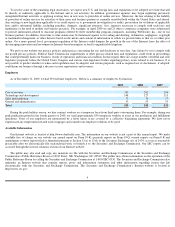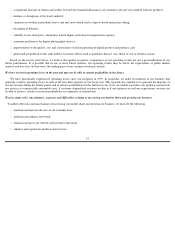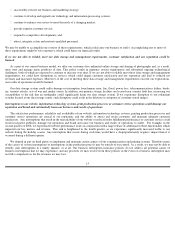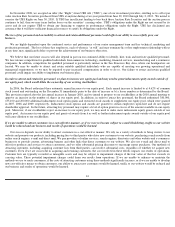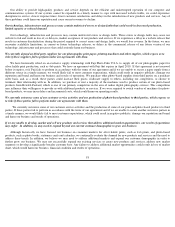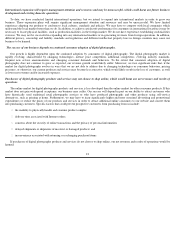Shutterfly 2010 Annual Report Download - page 17
Download and view the complete annual report
Please find page 17 of the 2010 Shutterfly annual report below. You can navigate through the pages in the report by either clicking on the pages listed below, or by using the keyword search tool below to find specific information within the annual report.
Many of our competitors have significantly longer operating histories, larger and broader customer bases, greater brand and name
recognition and greater financial, research and development and distribution resources, and operate in more geographic areas than we do. Well-
funded competitors may be better able to withstand economic downturns and associated periods of reduced customer spending and increased
pricing pressures. The numerous choices for digital photography services can cause confusion for consumers, and may cause them to select a
competitor with greater name recognition. Some competitors are able to devote substantially more resources to website and systems development
or to investments or partnerships with traditional and online competitors. Well-
funded competitors, particularly new entrants, may choose to
prioritize growing their market share and brand awareness instead of profitability. Competitors and new entrants in the digital photography
products and services industries may develop new products, technologies or capabilities that could render obsolete or less competitive many of
our products, services and content. We may be unable to compete successfully against current and future competitors, and competitive pressures
could harm our business and prospects.
If we are unable to adequately control the costs associated with operating our business, our results of operations will suffer.
The primary costs in operating our business are related to producing and shipping products, acquiring customers, compensating our
personnel, acquiring equipment and technology and leasing facilities. If we are unable to keep these costs aligned with the level of revenues that
we generate, our results of operations would be harmed. Controlling our business costs is challenging because many of the factors that impact
these costs are beyond our control. For example, the costs to produce prints, such as the costs of photographic print paper, could increase due to a
shortage of silver or an increase in worldwide energy prices. In addition, we may become subject to increased costs by the third-
party shippers
that deliver our products to our customers, and we may be unable to pass along any increases in shipping costs to our customers. The costs of
online advertising and keyword search could also increase significantly due to increased competition, which would increase our customer
acquisition costs.
We invest in securities that are subject to market risk and the fluctuations in the financial markets could adversely affect the value of our
assets.
At December 31, 2009, we held approximately $47.9 million par value of variable rate debt obligations with a fair value of approximately
$41.7 million, classified as short-term investments, with an auction reset feature (“Auction Rate Securities”)
whose underlying assets are student
loans which are substantially backed by the federal government. Since February 2008, these auctions have failed. Therefore our Auction Rate
Securities continue to be illiquid and we will not be able to access these funds until a future auction of these investments is successful or a buyer
is found outside of the auction process.
●
Drug stores such as Walgreens, CVS and others that offer in
-
store pick
-
up from Internet orders;
●
Regional photography companies such as Ritz Camera that have established brands and customer bases in existing photography
markets;
●
Internet portals and search engines such as Yahoo!, AOL, and Google that offer broad
-
reaching digital photography and related products
and services to their large user bases;
●
Home printing service providers such as Hewlett
-
Packard, Epson, Canon, and Kodak that are seeking to expand their printer and ink
businesses by gaining market share in the emerging digital photography marketplace;
●
Photo
-
related software companies such as Apple, Microsoft and Corel;
●
Social media companies that host images such as MySpace, Facebook and Hi5; and
●
Specialized companies in the photo book and stationery business such as Hallmark, American Greetings, Tiny Prints, Minted, Picaboo
and Blurb.
15


